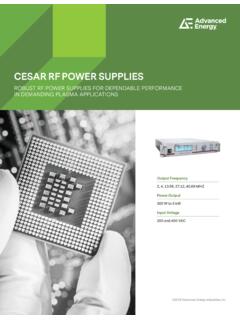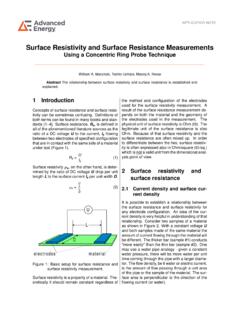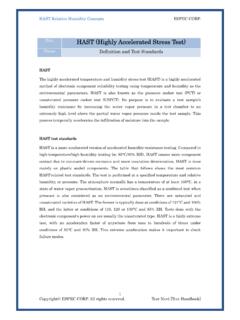Transcription of Accelerated Life Test Principles and Applications in Power ...
1 2018 Advanced Energy Industries, byMichael Shover, , Advanced Energy Industries, paper discusses using an Accelerated life Test (ALT) as a technique for demonstrating the mean time between failures (MTBF) with reduced test duration though the introduction of stressors. Test design necessitates the careful application of multiple acceleration models, as the aging of individual parts varies by failure mechanism. Usage of the lower confidence bound on MTBF as the primary metric accounts for temporal uncertainty. IntroductionBeginning early in the development cycle, certain reliability metrics are important to ascertain, to ensure that the resultant product meets industry and customer requirements.
2 One such measure is the long-term failure rate of the product, commonly expressed in MTBF. For high-reliability industrial systems, the MBTF greatly exceeds the available laboratory time to demonstrate this metric under standard field usage conditions. Although this challenge can be somewhat mitigated by increasing the sample size on test, it is often desirable and pragmatic to increase the rate at which failures occur. An Accelerated life Test (ALT) is the process of evaluating a product by subjecting it to stress conditions which exceed the standard field usage conditions, thereby increasing the rate of failure discovery. Table of ContentsMethods for Acceleration and Test Design 2 Summary 6 References 7 Accelerated life Test Principles and Applications in Power Solutions2 life TEST Principles AND Applications IN Power SOLUTIONSM ethods for Acceleration and Test DesignAll Advanced Energy product lines are comprised of many parts, of different types, with interactions internal and external to the product.
3 Thus, the reliability of a complex product, whether it is a Power delivery system, plasma source, high voltage Power supply, thermal instrumentation, or thyristor Power control module, comprises both the reliability of the constituent parts and inter-actions. The key part-level contributors to the reliability of Advanced Energy product lines are presented in three major categories: semiconductors; passive parts; and electromechanical of the time to failure of a semiconductor device are commonly assumed to be related to the applied stress through an exponential or Power -law dependence. An exponential dependence is best expressed through a form of the Arrhenius equation:where TF = time to failure, = exponential stress parameter, = generalized stress parameter which causes degradation, T = temperature, kB = Boltzmann constant, and Ea = the minimum quantity of energy necessary for the specific reaction, known as the activation energy [1].
4 A Power law dependence can be expressed aswhere n = the Power law exponent [1]. The mechanism for degradation and eventual failure of a semiconductor device determines which dependence is the best 1 summarizes the predominant failure mechanisms of Power silicon devices, from which two straightforward observations can be made. First, accelerating the failure rate of semiconductors solely through an increase in temperature applies to all the predominant failure mechanisms. Second, the activation energies associated with these failure mechanisms are approximately distributed across an order of magnitude. In both the Arrhenius and Power law models, this wide distribution is further amplified as an exponential 3 Accelerated life TEST Principles AND Applications IN Power SOLUTIONST able 1 Predominant Failure Mechanisms in Power Semiconductor Devices [2-4].
5 Accelerating FactorsEa (e V)Time-dependent dielectric breakdown (TDDB)Temperature, electric to chargeTemperature, injectionTemperature, electric to to diffusion into SiTemperature, current to acceleration factor is the ratio of the failure rates under elevated stress and field usage conditions:For an ALT with elevated temperature as the single-stressor, both the Arrhenius and Power law dependent models simplify to the ratio of the exponential PartsWhen operated with sufficient design margin, passive parts such as resistors, capacitors, and inductors generally have very high intrinsic times to failure. One of the main contributors to the failure rates involving passive parts is fatigue of the solder joints attaching these parts to printed circuit boards.
6 The Coffin-Manson equation is one method for estimating the cycles to failure due to fatigue: where q is a material constant, experimentally determined values for which are summarized in Table 2 [1,5]. Here, the key factor that can be varied in ALT is not the absolute part temperature, but the change in temperature between two states. For passive parts that have a constant temperature profile during typical field usage, this T would be between the dormant and active states of the product. Passive parts in a Power circuit may have an appreciable temperature rise between two active states, such as when the output is enabled at low and high Power levels.
7 The estimates for cycles to failure would be based on the greater of these two T values for a specific 2 Coffin-Manson exponents for sample (q)Soft metals (solder, Al)1-3 Hard metals / intermetallics3-6 Brittle materials (dielectrics)6-94 life TEST Principles AND Applications IN Power SOLUTIONSAs appropriate, more sophisticated empirical methods are used at Advanced Energy for quantifying solder fatigue, such as the Modified Engelmaier model [6,7]. Electromechanical PartsParts that physically move during product operation are a small subset of the constituent parts across Advanced Energy product lines. However, electromechanical parts generally have higher failure rates than semiconductors or passive parts and therefore warrant due to cyclical motion can be expressed by the Norris-Landzberg equation, here noted in terms of an acceleration factor:where f = frequency of cycling, m and n = material constants [8].
8 Cooling fans are a unique type of part. Their reliability depends primarily on the useful life of the bearing lubricant, and can be expressed by the Booser equation:where L = mean grease life and S = speed-related factor [9]. In both the Norris-Landzberg and Booser models, temperature plays a notable role in the ability to increase the part failure rate in of a Complex SystemThere are multiple constraints when designing and executing an Accelerated test for a complex product. The test must be designed in such a way that only failure modes which are relevant to typical field usage are Accelerated . Avoiding overstress failures on ALT requires a thorough analysis of the operating conditions of each part to determine the magnitude of stress that can be previously introduced concept of constituent part failure rate admixture presents a parametric trade-off for ALT design.
9 These types of constraints are best illustrated through an example. Consider a hypothetical system comprised of a semiconductor and a standard surface mount resistor. Assume that the known critical parameters aren The predominant semiconductor failure mechanism is through TDDB, with Ea = eV, active state temperature of 50 C, and Arrhenius dependence;n The resistor active states are at 40 C and 60 C and cycle every 5 Accelerated life TEST Principles AND Applications IN Power SOLUTIONSIn this example, when the stress temperature of the system is increased by 30 C, the acceler-ation factor of the semiconductor is approximately 21, while for the resistor the acceleration factor is Similar discrepancies exist for other cyclically operating parts and cooling fans.
10 On the contrary, an ALT designed to accelerate the resistor via cycling will have lower Arrhenius accel-eration, due to the reduced time at elevated temperature. These constraints are an important consideration in the design of Accelerated tests on a complex system. Calculation of MetricsOf interest prior to, during, and at the conclusion of the ALT are certain quantitative measures, including the MTBF. The simplest variant of an MTBF calculation is the point estimate, which is [10,11]:This formula is of practical use for larger data sets, including field data. The case of zero failures is mathematically treated as identical to the case of one failure to avoid an infinite result.












